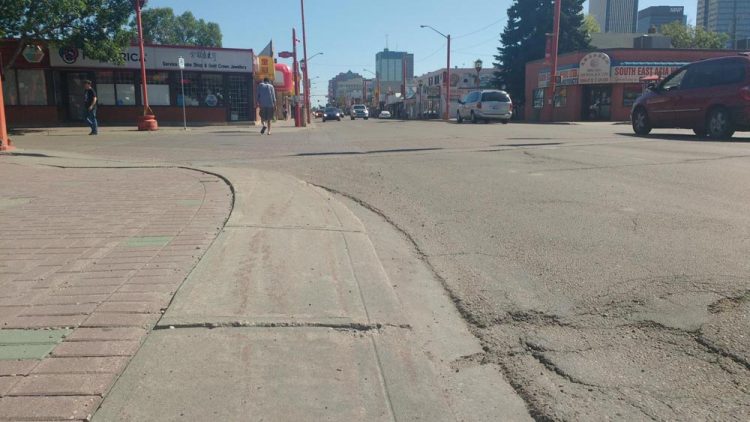Scientists on the road to discovering impact of urban road dust

The study examined road dust collected from Edmonton's downtown core in September 2016. Credit: Adam Medley
In an attempt to better understand the urban environment and its components, scientists have discovered that sunlight causes chemical reactions in the dust found on Edmonton roads.
“We found that when you shine light on road dust, it produces a reactive form of oxygen called singlet oxygen,” said environmental chemist Sarah Styler. “It acts as an oxidant in the environment and can cause or influence other chemical reactions.”
Just what those chemical reactions are and how they affect us is something the assistant professor in the University of Alberta's Department of Chemistry is determined to find out.
“Unlike tailpipe emissions, which are increasingly heavily regulated, road dust is much more complex and comes from many different sources,” explained Styler, who conducted the study by examining and analysing road dust collected from Edmonton's downtown core in September 2016, with her research team.
Road dust is made up of components such as exhaust emissions from vehicles, tire tread particles, debris from the road itself, and runoff from nearby parks and yards, said Chelsea Cote, a recent graduate and co-author on the study. As a result, attempts to regulate what makes up the dust on our roads would be extremely complicated–and difficult to quantify
Styler explained that if contaminants in road dust react with singlet oxygen, that means that sunlight could change the lifetime and potency of those contaminants in ways we don't yet understand.
One group of chemicals that could react with singlet oxygen are a set of toxic components of combustion emissions, known as polycyclic aromatic hydrocarbons.
“Our study shows road dust does something–it reacts with light–and now we need to learn just what that means,” explained Stephanie Schneider, another recent graduate and co-author on the study.
Next, the team will examine road dust from other places around the city, including residential, commercial, and park areas to better understand if and how the different composition of road dust will influence reactivity,” explained Cote.
###
The paper, “Photochemical Production of Singlet Oxygen by Urban Road Dust,” was recently published in Environmental Science & Technology Letters.
Media Contact
All latest news from the category: Ecology, The Environment and Conservation
This complex theme deals primarily with interactions between organisms and the environmental factors that impact them, but to a greater extent between individual inanimate environmental factors.
innovations-report offers informative reports and articles on topics such as climate protection, landscape conservation, ecological systems, wildlife and nature parks and ecosystem efficiency and balance.
Newest articles

Properties of new materials for microchips
… can now be measured well. Reseachers of Delft University of Technology demonstrated measuring performance properties of ultrathin silicon membranes. Making ever smaller and more powerful chips requires new ultrathin…

Floating solar’s potential
… to support sustainable development by addressing climate, water, and energy goals holistically. A new study published this week in Nature Energy raises the potential for floating solar photovoltaics (FPV)…

Skyrmions move at record speeds
… a step towards the computing of the future. An international research team led by scientists from the CNRS1 has discovered that the magnetic nanobubbles2 known as skyrmions can be…





















